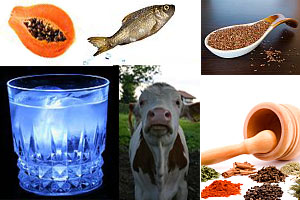[amd-zlrecipe-recipe:12]
Do You Know the Top Foods for Healthy Joints?
Keeping our joints healthy is one of the most important things we can do to remain independent and active as we age. Life can become quite challenging for individuals who are immobilized by joint pain, since it can result in reduced physical and social activity as well as a higher risk of psychological and emotional problems.
When it comes to joint health, exercise is very important, but what you EAT also plays a significant part. Here are some of our favorite joint-friendly foods:
Water — Perhaps the single-most important “food” is water. This liquid is essential for maintaining every system within the body. Water helps in the elimination of toxins, including those poisons that can create joint pain. Water also helps in the delivery of nutrients to the various parts of the body and—like the oil in your car—is essential for joint lubrication. Drink plenty of water every day!
Fish — Cold water fish, such as salmon, mackerel, sardines, white tuna, halibut and trout can deliver healthy doses of omega-3 from the fish oil in each serving. Omega-3 fatty acid is known to reduce inflammation that can cause or increase joint pain. Fish oil can also slow down cartilage degeneration. Cartilage is the rubbery substance between bones that allows for smooth movement. When this wears out, movement becomes extremely painful.
Dairy products — In addition to contributing to bone health, dairy products (and particularly low-fat ones) such as cottage cheese, yogurt and milk can also help eliminate painful gout symptoms.
Flax Seeds — Flax is another source of omega-3 and omega-6 fatty acids for great joint health. Flax seeds and flax seed oil are high in antioxidants, which help to prevent or delay some effects of aging. Flax also contains lots of fiber, which can help you feel fuller for a longer time, reducing the likelihood of snacking. Frequent snacking can lead to obesity—a condition frequently associated with joint pain.
Spices —Curry, ginger and cinnamon also have anti-inflammatory properties that can help your joints. Turmeric has been shown to be particularly effective in reducing the symptoms of osteoarthritis. With these spices in the mix, a joint-friendly diet certainly doesn’t have to taste bad or be bland.
Papaya —The Annals of Rheumatic Diseases published a 2004 study showing a strong correlation between low vitamin C intake and rheumatoid arthritis. Those with the lowest vitamin C consumption were 3 times more likely to develop the disease. Though orange juice has a good dose of vitamin C, papaya has nearly twice as much. Not only that, papaya also includes a good dose of beta carotene for even more anti-oxidant joint support.
Tart cherry juice — The anthocyanins contained in this juice are powerful anti-inflammatories that have been shown to reduce arthritis-related inflammation even better than aspirin. In addition, cherry juice is effective in reducing the painful symptoms of gout.
Hamburger Vegetable Soup
[amd-zlrecipe-recipe:11]
Do You Know all of the Health Benefits of Onions?!!
 10 Health Benefits of Onions
10 Health Benefits of Onions
Onions are considered one of the world’s healthiest foods and given that there are varieties of onions, how you use them could be different each time! Grown all over the world, the first record of using onion for health purposes and healing was in the 17th century. The truth is, onions are therapeutic, which is lucky, seeing as Americans eat over 20 pounds of onion per capita, per year. Want to know what is so good about them? Read on!
1. Improved Immunity
Onions contain powerful antioxidants. Antioxidants are flavonoid compounds, which delay or help repair oxidative damage to different cells and tissues in the body. Eating onion regularly can also protect the body and help regenerate the powerful antioxidant vitamin E, which the body needs as a fat-soluble nutrient. Plus, onion contains allicin. Allicin, a plant derived nutrient, is a killer of various viruses and bacteria, which means it’s a good thing if you eat some raw onion when you feel the onset of a cold or flu, this way the immune effect will be the strongest.
2. Reduce inflammation
When inflammation in the body is working properly, it fights against the disease or protect a wound, gets rid of the virus and then leaves the body, It’s when it goes a bit wrong and doesn’t leave the body, that your immunity is compromised. Naturally anti-inflammatory, onions can help fight inflammation, when the inflammation is the problem. Quercetin, found in onion, has proven to inhibit inflammation-causing leukotrienes and the prostaglandins and histamines that are in rheumatoid arthritis, and osteoarthritis. So it can help inflamed joints and chronic inflammation pain.
3. Regulate blood sugar
There has been extensive research into how onions affect blood sugar. This is good news for the 29 million people in the United States who have diabetes. The tests showed that people, who were diagnosed with type 1, and those with type 2 diabetes, had a lower blood sugar level (glucose reading) after eating onions, and it remained low for up to four hours after eating. This means onion could be very helpful in the management of diabetes. This is because of the sulfur compounds in onions that work to increase insulin production and, therefore, lower glucose levels.
4. Cancer preventer
Onions are the richest natural sources of Quercetin you can find. Quercetin is a powerful antioxidant flavonoid that has been linked to inhibiting certain kinds of cancers. Research and clinical trials have been undertaken to learn more about the effect of the quercetin in onions have on cancer, and it is not considered a drug to combat cancer. Eating onions will simply give you many good benefits that could lead to preventing cancer, because of the dietary source of quercetin it contains.
5. Healthy heart
These antioxidants such as quercetin, work to thin the blood and ward off blood clots. This is particularly the case if you eat raw onion. Raw onion lowers the chanced of bad cholesterol (LDL) which keeps hearts healthy. Not just for lowering your cholesterol, eating onions regularly can also lower blood pressure, and keeps the risk of heart attack and heart diseases or heart risks low. Heart risks including arterial hardening and gallstones. Any foods that support heart health are usually recommended by any heart foundation and are part of a balanced diet.
6. Vitamins and minerals
Onions are considered one of the world’s healthiest foods, not surprising as they contain multiple vitamins and minerals. First up there is a rather decent amount of vitamin C in onions, and we all know vitamin C is good for you. Onions also contain vitamin B6. B6 is great for red blood cell formation, Potassium, which is important for low blood pressure, and general heart health and Folate B vitamin bodies need for metabolism and cell growth. Not only the above but they are also a good source of dietary fiber, calcium, iron, low sodium and have no fat.
7. Free radical killer
Free radicals are molecules that attack healthy cells in the body. These free radicals want to steal all the good stuff from healthy cells, like electrons and rebalance, which cause damage to the good cells, this, in turn, affects the body in regards to aging and deterioration. And if your body is overrun with free radicals, oxidative stress is created. You can combat free radicals by eating foods that are high in antioxidants. Onions do this by eliminating free radicals, they even search them out and kill them, and therefore, reducing the aging process and your risk of developing other related diseases.
8. Onion cough syrup
You can make your cough syrup at home from onions, and it does, in fact, taste better than it sounds, and some may say, better than over the counter cough syrups. Using a red or yellow onion, slice it evenly and place at the bottom of a jar. Pour a layer of honey over it, then repeat layering onion slices, and honey until you are out of the onion. (You can use raw or brown sugar instead of honey if you like but it will be much sweeter) Cover the jar tightly and let it sit overnight. After up to 12 hours the liquid in the jar becomes your cough syrup. Take one spoonful, three times an hour. This concoction will begin to break up and mucus, its natural antibiotic properties begin to take effect and the honey works to soothe the throat.
9. Bee stings
The soothing properties of applying a freshly cut slice of onion directly onto a wasp or bee sting can immediately begin to take effect. The enzymes in onions can help break down the compounds found in the venom of a bee or wasp sting. This is what causes the inflammation and subsequent pain and even swelling. Applying onion can reduce all of these things initially. It also helps in the length of time the sting takes to heal. This ‘home remedy’ was once thought to be an old wives tale. Now it is commonly known to be correct, and more importantly, actually work!
10. The healthiest onions
Western yellow onions and shallots are considered the healthiest because of their phenolic and flavonoid content. In general, consuming these versatile vegetables is only ever a good thing, no matter what kind of onion. These two kinds of onions are both from the allium family, and they can be pretty easily interchanged in recipes. They have a slightly different taste in regards to pronounced sweet flavor (shallot) and bite (yellow onion). That does not make them unusable. If anything, it makes them more desirable to the palate, and to the health system.
Today’s article was written by Charmaine and is shared from the following website: http://health.facty.com/food/nutrition/10-health-benefits-of-onions/?utm_source=bing&utm_medium=c-search&utm_term=health%20benefits%20of%20onions&utm_campaign=f-h-10-health-benefits-of-onions&msclkid=57e38f7f3d051891d8f5d5c259ba940f
Almond-Honey Power Bar
[amd-zlrecipe-recipe:10]
Opiates Ineffective for Chronic Back or Hip Pain
 A new study just published in the Journal of the American Medical Association finds that opioids are not an effective solution for chronic pain.
A new study just published in the Journal of the American Medical Association finds that opioids are not an effective solution for chronic pain.
In this article, researchers from the University of Minnesota studied 240 patients who had chronic back, hip, or knee arthritis pain. Half of the study subjects received opiates; the other half received non-opiate pain medications. Patient progress was evaluated at 3-months, 6-months, 9-months, and one year.
The study found:
- There was no difference in pain-related function between the two groups.
- At 12 months, the nonopioid patients had less pain than did those who received opiates.
- “The opioid group had significantly more medication-related symptoms over 12 months than the nonopioid group”
The study authors write:
“Among patients with chronic back pain or hip or knee osteoarthritis pain, treatment with opioids compared with nonopioid medications did not result in significantly better pain-related function over 12 months. Nonopioid treatment was associated with significantly better pain intensity, but the clinical importance of this finding is unclear.”
Previous research has found that about 20% of patients with musculoskeletal pain are prescribed narcotic pain medications for their symptoms, and another recent study found that 36% of people who overdosed from opiates had their first opioid prescription for back pain.
Another recent study found that chiropractic patients are less likely to use opiates for their pain than are medical patients.
From this research, it seems clear that it’s risky to prescribe opiates for musculoskeletal pain. Chiropractic care is a proven safe and effective approach for both chronic and acute back pain.
Krebs EE, Gravely A, Nugent S, Jensen AC, DeRonne B, Goldsmith ES, Kroenke K, Bair MJ, Noorbaloochi S. Effect of Opioid vs Nonopioid Medications on Pain-Related Function in Patients With Chronic Back Pain or Hip or Knee Osteoarthritis Pain: The SPACE Randomized Clinical Trial. JAMA. 2018 Mar 6;319(9):872-882. doi: 10.1001/jama.2018.0899.
Sweet and Sour Sauce, No Added Sugar
[amd-zlrecipe-recipe:9]
Fitness Standards for Adults: Here’s What They’re Good For
President John F. Kennedy once said, “Physical fitness is not only one of the most important keys to a healthy body, it is the basis of dynamic and creative intellectual activity.” Since July 16, 1955, the American government has shown at least a political interest in the health of Americans. Under President Eisenhower, the President’s Council on Youth Fitness established a beachhead against the lagging health of American youth compared with citizens of other countries. Military officers in World War 2 complained that their recruits were out of shape. Perhaps Eisenhower’s program was meant to help reverse that condition. However, it wasn’t until President Kennedy that the Commander-in-Chief took an active role in promoting standards and committing resources to them.
After nearly 60 years, the presidential council has expanded its role in a number of directions, including sports, nutrition and—most relevant to this article—adult fitness. The president’s council has had an established standard for nominal health since 2008 and benchmarks have been created for regular, moderate and vigorous activity. In addition, the council has established an online Adult Fitness Test that allows you to compare your scores with those of fellow Americans. The test can be found at http://www.adultfitnesstest.org/dataEntry.aspx.
The areas tested include the following:
- Aerobic fitness—Preparing for the test, you should work up to moderate exercise (e.g. brisk walking) for 30 minutes, 5+ days per week; and vigorous exercise (e.g. running) for 20–30 minutes, 3–4 days per week.
- Muscular strength and endurance—3+ days per week, work up to 3 sets each of 25 half sit-ups and 10–20 push-ups. Between each set, include a short rest.
- Flexibility—Static stretches should be taken to the point of tension, but never to pain. Hold each for 10–30 seconds. Repeat 1–2 additional times.
- Body composition—Your body mass index (BMI) is a measure of height related to weight, with your waist measurement as a health indicator. This should be kept between 18.5–24.9. BMI calculators can be found online.
These sorts of tests can do a lot to raise public awareness and to help focus people on activities that will make a difference. But they will only be effective is they’re used the right way. And using them the right way starts with understanding what these tests are actually measuring and what the results mean. In some ways, measuring your performance in specific exercises relative to a national average may be less helpful than measuring your improvement over time and setting new goals based on your own progress.
When taking on any exercise program or fitness testing, especially when you have not engaged in rigorous physical activity regularly for several years, you should consult with a doctor or physical trainer. Proper preparation, good technique and consistency are the keys to staying healthy and avoiding injury. Regular chiropractic care can also play an important role in helping to speed recovery, prevent future injuries and improve performance. As musculoskeletal system specialists, chiropractors have unique insight into how patients can safely increase their strength, stamina, flexibility and balance. If you want to learn more, just call or visit our office! You can reach us at Oblander Chiropractic at 406-652-3553.
Top Foods for a Healthy Nervous System
The health of your nervous system is vital for maintaining all your body’s functions and avoiding a range of potentially serious health problems. But if you’re not getting a sufficient amount of the nutrients needed for good nervous system health, you can experience such as numbness, nervous twitches or even muscle cramps. Fortunately, one of the easiest things you can do to help ensure a healthy nervous system is to eat the right kinds of foods.
Here’s a quick overview of several nutrients that play a key role in keeping your nervous system healthy and working the way it should.
Vitamin B1 (thiamin)
A deficiency of this vitamin can give you that pins-and-needles sensation in the toes or burning feet, especially at night. Good foods for vitamin B1 are beef liver, seafood, brewer’s yeast, beans, eggs and sunflower seeds.
Vitamin B6
Nerve cell communication suffers without this vitamin. Two key neurotransmitters, dopamine and serotonin, depend on vitamin B6 for their production. Bananas, potatoes, and chick peas are good sources.
Vitamin B12
A shortage of this vitamin can result in tingling and numbness in the hands and feet. Clams, fish, eggs, meat and dairy products are key sources of vitamin B12.
Copper
Like vitamin B6, this mineral is essential for the production of neurotransmitters. A severe lack of copper in your diet can lead to spinal cord degeneration and a progressive failure of nerve function. Liver and oysters are the best sources. Add prunes, spinach and kale (as well as other dark, leafy green vegetables), and nuts to your diet for even more copper.
Healthy foods for good nervous system function include the following:
Spinach—In addition to containing a powerhouse stock of nutrients and vitamins, this leafy green vegetable also contains an abundance of antioxidants to boost overall health and slow down the aging of the brain and nervous system.
Whole grains—Brown rice in particular contains high levels of vitamin B6, which helps to protect against mental deterioration caused by high levels of harmful homocysteines. Whole grains also include magnesium, which is important for the health of your nervous system. Stabilized rice bran contains one of the highest levels of antioxidants of all known foods.
Cocoa—This contains a powerful antioxidant that puts the brakes on oxidative stress that can lead to Alzheimer’s and similar neurological ailments. It is also high in magnesium.
Whey—An excellent food for a naturally calming effect. Rich in L-tryptophan, which the body cannot produce, this essential amino acid is vital in the production of serotonin, an essential neurotransmitter. Low levels of serotonin can lead to depression.
Garlic—This not only includes antioxidants, but garlic can help prevent aging of the brain and prevent infections, too.
So try working more of the above foods into your weekly menus, and feel pleased that you are doing something good for the health of your nervous system!
If feel that you need help with improving your eating habits and diet, we are just a phone call away! You can call at Oblander Chiropractic at 406-652-3553. Dr. Oblander is always willing to meet with you to discuss your nutritional needs!
Exercise, Chiropractic More Effective Than Medicine
You may remember your grammar school gym class where the PE teacher would lead you in jumping jacks, push-ups, sit-ups and arm circles. If you’re like a lot of baby boomers, you probably look back and assume it really didn’t do much for the health of the students — just kept the class busy for an hour.
Elementary school days may be way behind you, but exercise carries many benefits now that it couldn’t offer a younger you, especially if you’re battling pain from an injury or chronic condition.
The Journal of Manipulative and Physiological Therapeutics published a report on randomized controlled trials, or RCTs, looking at the result of exercise as treatment for patients experiencing intense pain from soft tissue injuries in the hip, thigh or knee. Success was measured by the following factors:
- Intensity of pain
- Recovery
- Quality of life
- Psychological outcomes
- Adverse events
“One RCT found statistically significant improvements in pain and function favoring clinic-based progressive combined exercises over a ‘wait and see’ approach for patellofemoral (anterior knee) pain syndrome,” the study says. “Patients with patellofemoral pain syndrome or groin pain had the best results with clinic-based exercise programs.”
Head to Head to Head
An ABC News blog posted study results comparing the outcome of three different forms of treatment for pain. Results show that patients treated by chiropractic professionals and the individuals who received home exercise advice, referred to as HEA, had higher rates of success than those who turned to medication for relief. Just 13 percent of the patients who took medication reported a satisfactory reduction in pain, whereas, about two-thirds of those who were treated through either chiropractic care (32 percent) or HEA (30 percent) said they were pain-free.
A total of 272 patients, ages 18-65, who were suffering from recent-onset neck pain took part in the study, which the National Institutes of Health spearheaded.
“I always prescribe exercises and/or physical therapy for neck pain,” wrote Dr. John Messmer from Penn State College of Medicine. “I also tell patients that the exercises are the treatment and the drugs are for the symptoms.”
Dr. Lee Green, professor of family medicine at the University of Michigan, also talked to ABC News. “Doesn’t surprise me a bit,” Dr. Green said. “Neck pain is a mechanical problem, and it makes sense that mechanical treatment works better than a chemical one.”
The study, which was published in the Annals of Internal Medicine, singles out the effectiveness of spinal manipulation therapy, or SMT, to provide relief for patients with neck pain. Researchers found that in both the short-term and long-term statistics, SMT had the most effective outcome. The report adds that HEA proved equally effective at some points in the study.
Participants rated their pain at several intervals: 2, 4, 8, 26, and 52 weeks. This enabled scientists to draw specific conclusions, such as the evidence showing that 12 weeks of SMT provided greater pain relief than up to one year of medication.
Chiropractic Benefits
Your chiropractor can not only provide pain releif and preventatiive therapies, they can also guide you in choosing exercises that target the areas you need treating. Chiropractic visits, in addition to home exercise practices, are a way to double down on your odds of successful treatment.
The Mayo Clinic website says there are multiple benefits to using exercise in addition to chiropractic care for your joints, as well as improving general wellness. In combination they serve to:
- Strengthen the muscles around your joints
- Help you maintain bone strength
- Give you more energy to get through the day
- Make it easier to get a good night’s sleep
- Improve your balance
We’re not talking about the kind of punishing calisthenics that win you the Presidential Physical Fitness Award, but something to just curb your symptoms and add some range of motion. Consulting with a chiropractor and incorporating some exercise seems to be the best way to get a passing grade in pain relief.
This article was written by Martha Michael and is shared from the following website: exercise-chiropractic-more-effective-than-medicine






